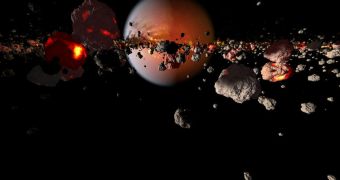The most widely-accepted theory over how the Moon formed suggests that it emerged from the debris field caused by a massive impact between Earth and Theia, a Mars-sized planet that existed in the early solar system. However, new data appear to indicate that this was not the case.
Under the old explanation, at least 40 percent of the magma the two bodies share must have come from Theia, with the remaining 60 percent accounted for by magma originally in Earth's interior. This theory is called the giant impact hypothesis.
One of the primary pillars supporting this idea is a series of studies conducted on lunar soil samples returned from the Moon by the NASA Apollo series. But the data show that the isotopic composition of lunar rocks is nearly indistinguishable from that of Earth.
This is a major problem for the giant impact hypothesis (GIH), considering that 40 percent of the magma that made up the Moon should have come from Theia, which presumably must have had a different isotopic composition than the early Earth.
Proponents of the GIH suggested that oxygen gas exchanges occurred between our planet's atmosphere and the debris disk from which the Moon eventually formed. However, the new study showed that this explanation does not stand up to scientific scrutiny.
University of Chicago in Illinois (UC) geochemists, led by expert Junjun Zhang, demonstrated in a research paper that Earth and the Moon have the exact same isotopes of titanium. The previous isotopic analyses were conducted exclusively on oxygen atoms.
The new discovery drives a final nail into GIH's coffin, experts believe. A paper detailing how the study was conducted is available in the March 25 online issue of the top journal Nature Geoscience. The research group also included experts from the University of Bern in Switzerland.
“The oxygen isotopic composition would be very easily homogenized because oxygen is much more volatile, but we would expect homogenizing titanium to be very difficult,” Zhang explains. He adds that other theories can now be used to explain the formation of the Moon, Science Now reports.
For example, it may be that a massive impact only dealt Earth a sideways blow, making our planet spin so fast that centrifugal forces ripped some of its mass and threw it into space. This would imply that the planet was significantly more massive when it first formed from the Sun's protoplanetary disk.
However, not all researchers are ready to give up on GIH just yet. Planetologist Matthias Meier, who is based at the Lund University in Sweden, is one of them.
“I think the general idea of having an impact forming a disk and this disk then forming a moon is probably right, but this paper shows us that we still don't understand exactly what the mechanism is, and there is a lot of work to be done in that field,” he comments.

 14 DAY TRIAL //
14 DAY TRIAL //